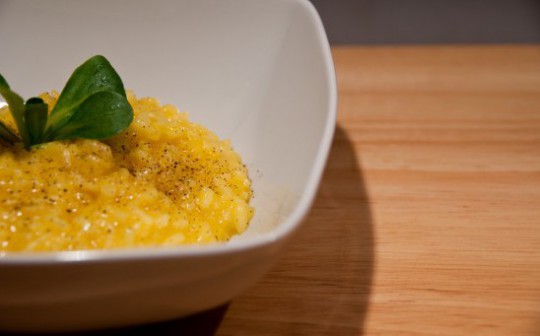Welcome to the Asymptote blog’s new monthly column of recipes in translation! We’ll feature incredible dishes from around the world that are a joy to cook and an adventure just to read.
The preparation of good risotto alla Milanese requires quality rice of the Vialone variety, with a wide grain somewhat harder than that of Carolina rice, which has an elongated, almost tapered form. A rice that isn’t entirely hulled—that is, not entirely stripped of its pericarp—finds favor among the true connoisseurs of Piedmont and Lombardy: the farmers who use it in their own kitchens. A careful observation of the grain reveals a coating of the residue of its shed film, the pericarp, a tattered walnut- or leather-colored garment of the lightest fabric. When cooked properly, it makes for excellent risotto that is nutritious and rich in the vitamins that distinguish common wheat and seeds with their shell-veils. Peasant-style risotto from these types of rice turns out particularly exquisitely, as does risotto alla Milanese: somewhat darker, it’s true, after and despite its golden baptism in saffron.
The classic receptacle for the preparation of risotto alla Milanese is a round—or even oval—tinned copper pan with an iron handle: the old, heavy pan that, after a certain point, we stopped hearing anything about. It’s a precious fitting of the old and ample kitchen: it was an essential component of the “kitchen copper” or “coppers”—one that the old poet, Bassano, did not fail to enumerate in his poetic “interiors” where, more than once, with lunch digested, the gleaming coppers hanging from the brick backsplash soak up and refract a ray of the setting sun. With the old copper abducted, all we can do is put our faith in its substitute: aluminum.

